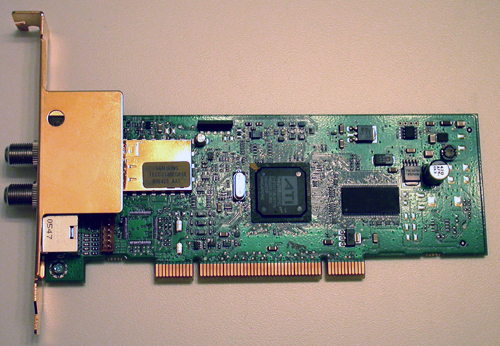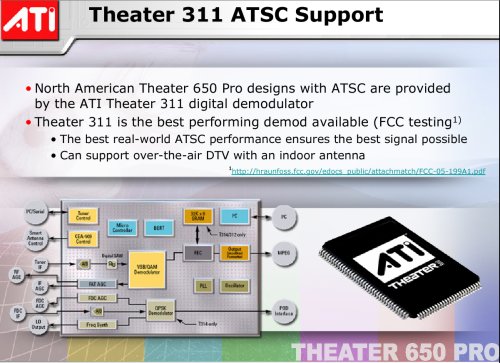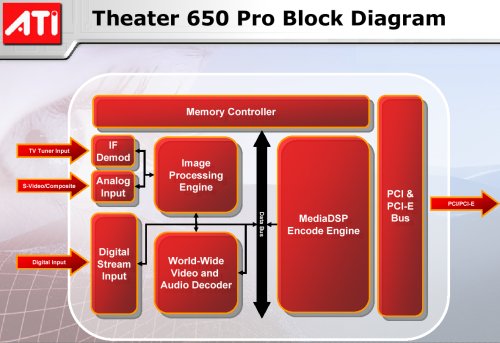The New Theater 650 TV Tuner Solution from ATI
by Josh Venning on June 14, 2006 4:00 AM EST- Posted in
- Smartphones
- Mobile
The Card
The Theater 650 may sport some new features, but the actual card is very similar to the older Theater 550 in size and appearance. The board we have is green in color, which is uncharacteristic of ATI parts (usually their cards are red, or in the A-I-W's case dark purple) but this is likely just because our card is a reference part, and the actual product color will depend on manufacturer preference. Aside from the color, the connections are exactly the same as on the 550, with the Antenna/FM and cable TV inputs, as well as an audio/video input at the bottom.


Being a reference part, our card didn't come with any kind of software bundle, but depending on which manufacturer distributes the card, it will most likely be packaged with the same types of software and accessories that 550 cards come with. Some of the partners who will be distributing the Theater 650 are well known companies like MSI , PowerColor, ASUS, Sapphire and VisionTek.
Architecture
The architecture of the Theater 650 is very similar to the 550, but with a few in changes. The 650 (for NTSC/ATSC countries) includes a Samsung mini-can tuner capable of tuning both analog and digital channels. The "mini-can", from what we understand, is an analog tuner (like the old tin-can tuners that wasted huge amounts of board space) shrunken down to fit in the same area as a silicon tuner. This is a best of both worlds situation where we don't need to worry about the board space of a tin-can, and we shouldn't run into the tuning speed issues we can sometimes see on silicon tuners.
The tuner feeds into both a Theater 311 demodulator and the Theater 650 chips. The Theater 311 digital demodulator supports over-the-air DTV (ATSC) with an indoor antenna. This is an in-house demodulator designed by ATI for their digital TV group, and ATI is very proud of the quality of this part. Testing the Theater 311 and the digital TV capabilities of the Theater 650 are beyond the scope of this article, but we will certainly be looking into these features in the future.

As the tuner feeds into the Theater 650 chip, the signal is internally demodulated and passed into the image processing engine. This is where functions including 3D comb filtering, motion adaptive noise reduction, de-interlacing, and edge enhancement take place. After this step, the cleaned up video flows over to the MediaDSP Encode Engine. Here, ATI is capable of performing the media center requisite MPEG-2 encoding in hardware. In addition to this feature, ATI has included the ability to encode to MPEG-4 (DivX and H.264) and WMV9, through the upcoming Catalyst Media Center software. These are features we are certainly interested in testing when we are able to do so.

We are quite happy to note that with all the additional filtering and feature capabilities ATI has included, they will also be enabling end users to adjust all of these settings at a very low level. Users who know exactly what they want from noise reduction, edge enhancement, and all the other filters will be able to tweak the settings as necessary.
Features
Let's talk a little bit now about the features of the Theater 650. Being the next installment of ATI's Theater series, it will naturally include many of the features of the previous Theater 550 like worldwide audio and NTSC and PAL video standards. However, this time around ATI has added many new features not included in their older cards, or in many competing solutions for that matter.
Firstly, as we mentioned in our introduction, one of the more interesting new features of the Theater 650 is its added digital capabilities. The card is touted by ATI as using next-generation DTV technology which is not yet available in consumer electronics. Basically, the Theater 650 provides digital TV support in ATSC (Advanced Television Systems Committee) for US, Canada, Mexico, and South Korea, as well as DVB-T (Digital Video Broadcasting Terrestrial) for European digital standards. Again, this is one of the first PC tuner cards to incorporate this feature, and certainly the first with the brand recognition of ATI.
ATI has also added some features to the 650 which address image quality, and should provide a better looking video stream. Motion adaptive 3D comb filtering has been included, which will provide sharper video and less false color. Edge enhancement has also been added to improve on image sharpness, and ATI has thankfully given users the option to turn this off, as many users prefer having control over this aspect. Better noise reduction is incorporated as well, and it is now motion compensated for sharper images with less static. Another feature is updated automatic gain and color control, which will provide brighter colors and faster brightness adjustment.
ATI has also designed the Theater 650 to be supported by the new Catalyst Media Center software which will replace ATI's previous Multimedia Center. There will be a new interface and it will provide much more user control over different aspects of video quality (like filters), which is a welcome feature.
All of these features add up to an impressive package which looks to be a significant improvement over the previous Theater cards by ATI. Specifications and buzzwords don't always correlate to a dramatic improvement in real-world applications, however, so we of course need to do some actual testing to see how image quality and CPU utilization on the Theater 650 compares to the Theater 550 and the NVIDIA DualTV MCE.
The Theater 650 may sport some new features, but the actual card is very similar to the older Theater 550 in size and appearance. The board we have is green in color, which is uncharacteristic of ATI parts (usually their cards are red, or in the A-I-W's case dark purple) but this is likely just because our card is a reference part, and the actual product color will depend on manufacturer preference. Aside from the color, the connections are exactly the same as on the 550, with the Antenna/FM and cable TV inputs, as well as an audio/video input at the bottom.


Being a reference part, our card didn't come with any kind of software bundle, but depending on which manufacturer distributes the card, it will most likely be packaged with the same types of software and accessories that 550 cards come with. Some of the partners who will be distributing the Theater 650 are well known companies like MSI , PowerColor, ASUS, Sapphire and VisionTek.
Architecture
The architecture of the Theater 650 is very similar to the 550, but with a few in changes. The 650 (for NTSC/ATSC countries) includes a Samsung mini-can tuner capable of tuning both analog and digital channels. The "mini-can", from what we understand, is an analog tuner (like the old tin-can tuners that wasted huge amounts of board space) shrunken down to fit in the same area as a silicon tuner. This is a best of both worlds situation where we don't need to worry about the board space of a tin-can, and we shouldn't run into the tuning speed issues we can sometimes see on silicon tuners.
The tuner feeds into both a Theater 311 demodulator and the Theater 650 chips. The Theater 311 digital demodulator supports over-the-air DTV (ATSC) with an indoor antenna. This is an in-house demodulator designed by ATI for their digital TV group, and ATI is very proud of the quality of this part. Testing the Theater 311 and the digital TV capabilities of the Theater 650 are beyond the scope of this article, but we will certainly be looking into these features in the future.

As the tuner feeds into the Theater 650 chip, the signal is internally demodulated and passed into the image processing engine. This is where functions including 3D comb filtering, motion adaptive noise reduction, de-interlacing, and edge enhancement take place. After this step, the cleaned up video flows over to the MediaDSP Encode Engine. Here, ATI is capable of performing the media center requisite MPEG-2 encoding in hardware. In addition to this feature, ATI has included the ability to encode to MPEG-4 (DivX and H.264) and WMV9, through the upcoming Catalyst Media Center software. These are features we are certainly interested in testing when we are able to do so.

We are quite happy to note that with all the additional filtering and feature capabilities ATI has included, they will also be enabling end users to adjust all of these settings at a very low level. Users who know exactly what they want from noise reduction, edge enhancement, and all the other filters will be able to tweak the settings as necessary.
Features
Let's talk a little bit now about the features of the Theater 650. Being the next installment of ATI's Theater series, it will naturally include many of the features of the previous Theater 550 like worldwide audio and NTSC and PAL video standards. However, this time around ATI has added many new features not included in their older cards, or in many competing solutions for that matter.
Firstly, as we mentioned in our introduction, one of the more interesting new features of the Theater 650 is its added digital capabilities. The card is touted by ATI as using next-generation DTV technology which is not yet available in consumer electronics. Basically, the Theater 650 provides digital TV support in ATSC (Advanced Television Systems Committee) for US, Canada, Mexico, and South Korea, as well as DVB-T (Digital Video Broadcasting Terrestrial) for European digital standards. Again, this is one of the first PC tuner cards to incorporate this feature, and certainly the first with the brand recognition of ATI.
ATI has also added some features to the 650 which address image quality, and should provide a better looking video stream. Motion adaptive 3D comb filtering has been included, which will provide sharper video and less false color. Edge enhancement has also been added to improve on image sharpness, and ATI has thankfully given users the option to turn this off, as many users prefer having control over this aspect. Better noise reduction is incorporated as well, and it is now motion compensated for sharper images with less static. Another feature is updated automatic gain and color control, which will provide brighter colors and faster brightness adjustment.
ATI has also designed the Theater 650 to be supported by the new Catalyst Media Center software which will replace ATI's previous Multimedia Center. There will be a new interface and it will provide much more user control over different aspects of video quality (like filters), which is a welcome feature.
All of these features add up to an impressive package which looks to be a significant improvement over the previous Theater cards by ATI. Specifications and buzzwords don't always correlate to a dramatic improvement in real-world applications, however, so we of course need to do some actual testing to see how image quality and CPU utilization on the Theater 650 compares to the Theater 550 and the NVIDIA DualTV MCE.










78 Comments
View All Comments
rqle - Wednesday, June 14, 2006 - link
Currently own a Theater 550 chipset and i like it much better then my roommate nvidia dualTV one. My question is, can i buy another Theater550 so i can dualTV, would the system go crazy on me? Would like to have dual screen running different sport program at once and would be cheaper for me as well.DerekWilson - Wednesday, June 14, 2006 - link
that would work fineWoodchuck2000 - Wednesday, June 14, 2006 - link
When is Anandtech going to publish a decent article on TV tuners? In no particular order:Why use ATI promotional material that is designed to prove that the 650 is better than the 550? Use your own material if you want a fair test. More to the point, why transcode it? Im sorry, but file size considerations are not a good justification for degrading the image quality <IN AN IMAGE QUALITY TEST>.
How do you justify adding throwaway comments about equivalence with Hauppage products in the conclusions if you havn't addressed the cards at any point in the review?
Why have you taken the instantaneous CPU utilisation from task manager and tabulated it? You need to take an average over a reasonable period of time if it is to have any relevance.
Seriously, there's not enough depth in any area to make the review really worthwhile - you may as well post a single page saying "Look everyone, ATI have sent us this nice new card they want us to plug!" and it would have the same amount of relevance to 99% of your audience.
Cardio - Wednesday, June 14, 2006 - link
Why is there no mention of how this card preforms on DTV, that is its major difference and only really new feature? Am I missing something here? You didn't test the Hauppauge because you have looked at it before. You've looked at the ATI 550 before also. In the earlier test you campare a dual tuner card to a single tuner card rather to the other available dual tuner card. Will ATI only give you stuff to test if you don't compare it to the competition? As you said, Nvidia's card is only available directly from them and at twice the price. The Hauppauge MCE 500 is available anywhere and is cheap. Oh, you have looked at those cards before.I can tell you for sure that I am a lot more interested in Picture Quality and functionality than in power consumption or cpu usage.
Not worthy of AT and its getting to be a habit.
DerekWilson - Wednesday, June 14, 2006 - link
We transcoded it for your benefit (smaller file to download) -- in our image quality analysis, we used the unmodified output of the cards. Sorry if this was unclear.As for using ATI's material, you can't argue with a zone plate. Better is better and worse is worse. Same for the other tests we ran which were designed by SMPTE (http://www.smpte.org/)">http://www.smpte.org/) ... ATI was gracious enough to provide us with these tests we would have otherwise had to purchase ourselves.
testing the Hauppage card is a reasonable request, but it doesn't change the fact that it was similar in quality and performance to the Theater 550 in previous evaluations. That is perfectly reasonable information to use in drawing conclusions.
SHSPVR - Wednesday, June 14, 2006 - link
One thing I really hate more then anything is the fact that min reviewer are so lazy in the cheating game by using the PrtScn Button and do not do ture original video RAW decode MPEG screenshot in the rigth application software like Womble MPEG-VCR and always seem to be using MCE DVR-MS proprietary video and audio format carp what matter are they just to lazy in using other PVR software or GraphEdit to get real MPEG files but as we all know that the NVIDIA DualTV is not option with GraphEdit which has no exposes advanced features properties.2nd problem as today no body turely using low bitrate under 4MBit/sec which is more reasonable testing to see how well it really dose encoding without artifacts.
So you wondering why I said cheating well each encoder dose there video difference from each other and there for the decoder filter display difference in case depend on the clean up filter like Deinterlace, difference Enhanced Video Processing Technologies which get apply on top the MPEG Video.
Now as for comparison.
Hauppauge, ATI and NVIDIA
Hands down Hauppauge PVR cards wins becuase of some major reason it has support for more OS then any one eles Windows, Linux, Mac (Apple) and yes even OS/2 Warp or eComStation and has more 3rdparty application support.
As for a real encoding comparison all test they should done with the fellowing device
VCR, Stardard Antenna TV, CableTV Analogue/Digital and Satellite with fellowing output source S-Video/Composite and Tuner
CPU Utilization is really useless becuase all of today Video card are still mostly base on 3rdparty SW-Decoder which mean you still need fast CPU unlike a ture HW-Decoder which provides a real decoding performance unlike today video card which only do part HW-accelerated decoding not full HW-decoding.
Let say for Example you have Intel P3 800MHz runing 2000Pro or XP with 512MB and you can chosse from GeForce"4" MX4000 or GeForce"7" 7800 becuase you want upgarde your old doggie ATI 3D RAGE PRO 4MB what do you think you see in CPU Utilization from the two card newer card.
andrep74 - Tuesday, June 20, 2006 - link
One thing I really hate more [than] anything is the fact that I have to try to read cr*p like your comments, which try to pass off the sh*t in your head for English.SHSPVR - Wednesday, June 14, 2006 - link
Oh I also for add You need do Cartoon as well as reg video show